KT says it took 4.6 times the number of LTE sites to provide 5G coverage
AUSTIN, Tex.–Several years ahead of the 2018 PeyeongChang Winter Olympics, Korean operator KT laid ambitious plans to showcase 5G technology — and did indeed pull off its deployment of a 5G network that allowed Olympics attendees to get a taste of 5G-enabled immersive entertainment and autonomous vehicles.
Dr. Won-Yeol Lee, director of the 5G access team at KT’s Infra Lab, gave the audience at the 5G New Horizons event an insider’s view of the network deployment and the 5G services that KT delivered. He said that the biggest challenge in the years leading up to the event was working with the global telecoms industry and 3GPP to get 5G standards delivered in time to guide KT’s work, with such an ambitious trial scheduled for early 2018.
Lee said that as the industry has asked what the “killer app” for 5G will be, KT tried to explore some of the potential answers — and the carrier is opening up a new 5G lab next month so that, as Lee put it, “all 5G players will be able to participate by developing and validating their own, fresh ideas.
“We believe this goes a long way toward the preparation for 5G commercial launch,” he added.
The five ways that KT provided 5G services at the Olympics were:
Sync view, which provided a real-time, first-person view of events such as the high-speed bobsleigh races, where participants reach speeds of up to 75 miles per hours while laying on or sitting in sleds racing down an icy track.
Interactive time slice let users watch high-definition video from at events such as ice hockey, the short-program figure skating and half-pipe snowboarding and smoothly choose and change the camera angles with very little latency. In a demo video, Lee showed how users could rotate the video perspective to get a 360-degree view of the athletes and access related augmented reality information.
Omni view utilized 5G as wireless backhaul for live cameras in distant parts of the Olympics venue, giving real-time feeds of events such as cross-country skiing and allowing users to track the progress of the entire field of participants on a digitalized version of the course and switch to live video feeds from around the venue to watch the progress.
360 Virtual Reality was used for events such as ice hockey, figure skating and free-style skiing, which included slicing and reconstructing images so that viewers could have a first-person VR perspective on the events.
5G autonomous vehicles were also available for Olympics visitors. Lee said that KT ran a large bus, a mini-bus and a car that were all 5G-equipped for autonomous operation and allowed riders to choose from entertainment services inside that were enabled by the high bandwidth provided.
Lee offered some lessons learned from KT’s 5G deployment experience for the Olympics.
“The first key issue arising is the cost,” he said, explaining that it took 4.6 times the number of LTE sites that KT had in the area to provide adequate 5G outdoor coverage, due to the characteristics of the 28 GHz millimeter wave spectrum that KT utilized for the network. KT had the area covered with 46 LTE sites, but it took 212 sites to provide equivalent 5G outdoor coverage, he said. Lee added that the need to densify to ensure coverage was much the same with 3.5 GHz spectrum, which KT plans to use for its national 5G network and augmenting with 28 GHz for additional capacity.
Korean operators have plans to share some 5G network infrastructure in order to reduce the overall cost of deployment.
Lee described the deployment and spectrum costs as “extremely high.”
“If we cannot find the right use cases, maybe operators will [go] bankrupt,” he said in response to an audience question about positive and negative takeaways from the deployment. “We are looking for that solution.”
-Indoor coverage was difficult, Lee said, because “penetration was an issue.” While KT found that millimeter wave spectrum worked 5G needed indoor repeaters or small cells in order to establish indoor coverage, he said. Lee added that while KT has a dense network footprint in urban areas that will largely provide what is needed for outdoor coverage, reaching users indoors will be a deployment challenge.
-The third lesson learned was that in order to support very low-latency applications, edge cloud computing resources needed to be placed in close proximity to users — and that will have to be accounted for in 5G network planning, he noted. KT was able to achieve roundtrip latency of 7-8 milliseconds, Lee said.

